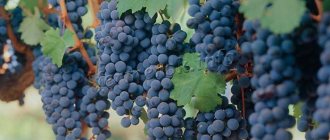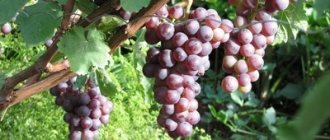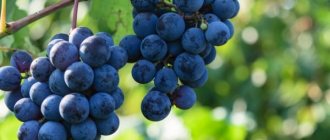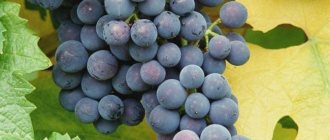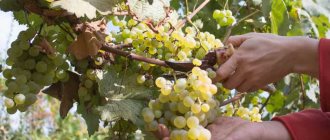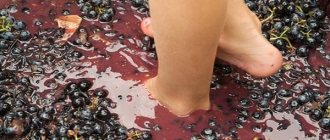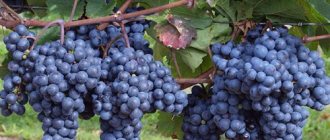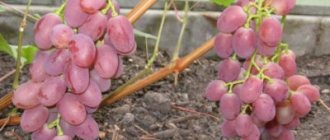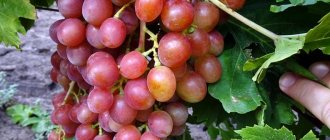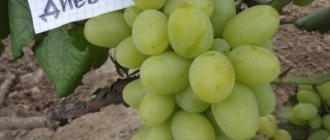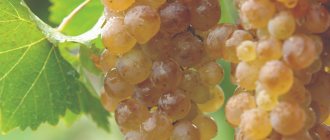Advantages and disadvantages
Any variety has a number of advantages and disadvantages; below are the pros and cons of “Rochefort”.
Pros:
- Large clusters and berries.
- Early ripening.
- The berries are sweet, pleasant to the taste, with a delicate aroma.
- High resistance to mildew and oidium.
- Transportability and long shelf life.
- Frost resistance.
- Fast rooting of cuttings.
Minuses:
- Not resistant to phylloxera.
- Does not tolerate drafts and cold winds well.
- Prone to peas.
- The berries are filling with color while they are not yet ripe.
Advantages and disadvantages of the variety
Most gardeners believe that Rochefort is one of the best grapes. It is characterized by fast ripening, high yield and unpretentious care.
The main advantages of Rochefort grapes:
- The presence of a flower of both sexes. They ensure rapid pollination and regular harvests.
- Suitable for transportation and excellent presentation.
- High resistance of berries to fungal diseases.
- The elementary nature of reproduction. The cuttings take root and develop.
- The bush is not afraid of winter frosts. The main thing is that the temperature does not drop below -23 degrees.
- The variety does not need special care, so without fertilizing and loosening it will not go to waste and will produce a good harvest.
The main disadvantages of Rochefort grapes:
- The berries are poorly stored after cutting.
- Susceptible to phylloxera. The variety should be protected from this pest. Phylloxera affects the roots of the bush, and it is almost impossible to get rid of the disease. If it hits the bush, then after a while it will have to be completely thrown away.
- Sick from drafts and strong winds. They are especially dangerous for the plant during flowering. Enormous harm is deprivation of the harvest, encircling the inflorescences and flowers. Place the grapes in windless areas, away from open areas.
Origin
Roshford's parents are "mascot" and "cardinal"
“Rochefort” is one of the new grape varieties. It was bred in a private vineyard by national breeder E.G. Pavlovsky. The varieties “Talisman” and “Cardinal” were chosen as parents, as well as a mixture of pollen from cold- and disease-resistant European-Amur grape varieties and hybrids.
“Talisman,” part of the “family of delight,” gave “Rochefort” the genes for large berries and resistance to frost and disease. From “Cardinal” “Rochefort” got its excellent appearance and taste.
Thanks to its good presentation, excellent taste and low maintenance requirements, “Rochefort” inherited from its parents, made it one of the standard grape varieties.
How and with what drugs to treat grapes
Rochefort grapes exhibit average resistance to major grape diseases. All treatments carried out on bushes of this variety are standard and are sufficient to avoid diseases. It is important that preventive measures include spraying the bushes and soil with a 3-5% solution of iron sulfate before covering the vineyard, as well as treating with a 3% Bordeaux mixture before flowering. Fungicides are also used for preventive purposes after bushes bloom and after precipitation.
| Diseases | Sustainability |
| Downy mildew (mildew) | Average |
| Oidium | Average |
| Gray rot | Average |
| Philoxera | Low |
Main characteristics
Unlike other breeders who like to show off and praise a new variety, Pavlovsky often underestimates his hybrid forms. In the case of “Rochefort”, it turned out that the hybrid has higher resistance to diseases than Evgeniy Georgievich assumed.
Ripening period
One of the positive qualities of this grape variety is its very early ripening period. The berries ripen 105-110 days after the start of the growing season. The southern regions can enjoy sweet berries by the end of July.
Rochefort fruits fill with color much earlier than they are fully ripe. If the bunch has acquired a dark purple color, do not rush to remove it from the bush. Wait for the berries to absorb sugar. After about a week, the berries will be filled with sweetness and acquire a light nutmeg taste.
Abundant Roshford harvest
Bush
“Rochefort” bushes are vigorous. The leaves are bright green, slightly pubescent. The vine can reach a length of 1.4 m and ripens almost completely.
The bushes begin to bloom in early June, so the crop is not afraid of spring frosts. Grape flowers are bisexual, which promotes abundant fruiting, because They pollinate themselves and do not need additional help.
As the bush grows, it is tied to a support. As a rule, “Rochefort” is grown on a single-plane trellis. This option is especially convenient for regions with a cool, changeable climate. In the fall, when it is necessary to remove the vine from the support for shelter for the winter, it will be much easier to do this with this forming.
Important! The distance between the bushes should be 2 m, and between the rows 4 m. This will ensure good illumination for the plant and the bushes will not shade each other.
Bunches and berries
Large clusters of conical or cylindrical-conical shape ripen on the Rochefort bushes. The density of the bunch is moderate. The weight of a bunch of own root crop reaches a mass of 600 g to 1200 g. Rootstocks of vigorous varieties produce much larger clusters.
Winegrowers note the good presentation of the bunches of this variety due to the fact that the ripening of the berries occurs simultaneously throughout the entire bunch.
The berries of this hybrid are round, very large, slightly flattened on the sides. Their average weight is 8-12 grams, but larger specimens are also found.
During ripening, the fruits acquire a dark purple color; when overripe, they become almost black.
The shape of the berries resembles prunes and has a bumpy surface. Each grape has 2-4 seeds.
“Rochefort” is not prone to peas. But gardeners noticed that the bunches often contained small, unripe berries.
With good care, favorable climatic conditions and regular feeding, 1 bush can produce from 6 to 10 kg of berries.
Taste
The fleshy pulp is sweet and pleasant to the taste, with a slight nutmeg flavor and aroma. The rather dense, but thin and delicate skin is practically not felt when eating the berries.
The pleasant taste of Rochefort is ensured by its ability to accumulate sugar and low acidity. The sugar content of the variety is 14-15%. Acidity - up to 5 g/l.
Proper feeding improves the taste, yield and presentation of this grape variety.
Fruiting of the hybrid form "Rochefort"
The bunch of "Rochefort" is beautiful, conical in shape, good density, reaching 20-30 centimeters in length. Depending on growing conditions, it weighs 0.5 - 0.9 kilograms, sometimes reaching 1.5 kilograms. The density of berries in the bunch is average. The berries in the cluster are round, spherical in shape, and usually weigh 10-15 grams. The color of the berries is pink-red; when exposed to the sun for a long time, they acquire a dark purple color. The diameter of the berries is approximately 2.5 - 3 centimeters.
Features of cultivation
“Rochefort” is valued by winegrowers for its unpretentiousness. This variety, even with little care, gives a good harvest, practically without losing the properties of the bunches and berries.
Reference! If you follow agrotechnical growing methods and provide the necessary conditions for “Rochefort”, then the grapes will delight you with a more abundant harvest of large and sweet fruits.
Landing
Rochefort seedlings are planted both in autumn and spring. In the fall, you need to have time to plant and cover young plants a month before the first frost. Planting is usually done in mid-October. It is important to consider the growing region and monitor weather conditions.
When planting in spring, seedlings prepared in the fall are planted, or cuttings are grafted onto dormant rootstocks. If the planting material has already buds, it should be planted only after the temperature has reached +18°C and night frosts do not threaten young plants.
This grape variety loves warmth and does not tolerate drafts. To plant it, you need to choose a well-lit and unshaded place on the south or southwest side of the site. Do not plant grapes close to the house or other buildings so that they do not create shade. More details about the ideal place for planting in a separate article.
This variety has no specific soil requirements. However, practice shows that grapes grow poorly in sandy soil and loam and produce few fruit-bearing shoots. In dense and heavy soil, grapes slow down their development, the yield decreases, and the berries become smaller.
“Rochefort” grows best on light soils that allow water and air to pass through well. The roots of the plant can go down to a depth of 3 meters, so it is important to monitor the composition of not only the top layer of soil, but also the deeper layers.
Watering and fertilizing
“Rochefort” is moisture-loving. It needs to be watered at least three times during the season: at the beginning of the growing season, before flowering and during the formation of berries.
Watering is carried out in the evening, in the absence of scorching sun rays, with settled warm water. Additionally, watering is carried out during drought.
Important! During flowering and fruit ripening, you need to stop watering the grapes. Excess moisture can cause flowers to fall off or berries to crack.
All necessary fertilizers are added to the hole during planting of grapes. If this condition is met, then in the next 4-5 years the plants will not need additional feeding.
Subsequently, the grapes are fertilized at least twice per season - in the spring, immediately after removing the cover, and in the fall, before the cover. Fertilizing is carried out with organic or complex mineral fertilizers.
Fertilizers contribute to better development of bushes, increase the yield and taste of fruits, and also make plants resistant to various diseases.
Trimming
Formative and sanitary pruning is carried out in autumn and spring. During this process, it is necessary to remove excess and damaged shoots.
Pruning is done so that the load on the bush is no more than 35 buds. On each shoot you need to leave 6-8 eyes.
Autumn pruning is carried out before the onset of frost. And in the spring, work on the formation of a bush should be carried out when there is slight warming, up to +5°C, until sap flow begins and the bushes wake up.
Diseases and pests
Rochefort grapes have average disease resistance. The most common fungal disease in this variety is powdery mildew. It can be recognized by a whitish coating on the leaves. The fungus spreads very quickly, so you need to take action at the first sign.
“Rochefort” is not resistant to phylloxera (grape aphid). To prevent infection by aphids and preserve not only the harvest, but also the entire vineyard, preventive spraying with insecticides is carried out.
If pests are detected, infected bushes are dug up and burned. The rest of the vineyard is treated with chemicals. New bushes cannot be planted in place of infected bushes for 10 years.
Important! During the ripening period of the bunches, chemicals and insecticides should not be used.
Preparing for winter
The variety has a fairly high resistance to frost and can withstand temperatures of -23°C. In regions with harsher winters, bushes are covered for the winter.
To cover, the vine is removed from the support and laid on the ground. The branches are secured with staples and covered in one of the available ways. For example, earth, straw, pine needles or plastic film.
Harvest storage
The grapes can be stored on the bushes for up to 3 weeks without falling off. The cut bunch is easily transported in wooden or plastic boxes and is stored for a long time without losing the appearance and taste of the berries.
Regions
The variety is recommended for cultivation in the southern regions. But thanks to its good frost resistance, its cultivation is also available to gardeners in colder climatic zones. Such as: Moscow region, Urals and Siberia.
In regions with harsh winters, you need to take care in advance about covering the vine for the winter: choose a convenient bush formation and select materials for insulation.
Productivity and ripening time
The plant produces its first signal harvest in the 2nd year after planting, marketable fruiting begins in the 4th - on average, one bush yields about 14 kg.
The opinion of an experienced Ukrainian gardener about the yield potential can be found in the following video:
According to the results of field tests in the natural conditions of Kuban (when bushes were placed according to a pattern of 3.0 x 1.5-2.0 m, formed like a horizontal cordon or a standard-less fan and growth was carried out on a vertical trellis), five-year-old plantings showed a yield of 9.6 -13.3 kg per plant or 15.8-21.9 t/ha. Moreover, during the growing season, care consisted of standard agrotechnical measures.
Removable maturity occurs 90-105 days after bud break . In the southern regions, the harvest reaches its highest condition at the end of July, and in cooler regions - in the first ten days of August. The clusters can remain on the bush for a long time without deteriorating the quality of the fruit. The taste and aroma, even after removing the brushes from the bush, remain unchanged for a long time.
The yield of five-year plantings of the variety in the Central zone of Kuban amounted to almost 22 t/ha
The berries are firmly held on the stalks, which has a positive effect on the keeping quality of the fruit. When harvested correctly, the fruits do not spoil and are stored well in the refrigerator for more than 2 months. The juicy pulp is perfectly protected from damage by the dense skin, which is practically not damaged during transportation, so the variety is recommended primarily for industrial cultivation for commercial purposes.
Comparison with analogues
Also, with the participation of the varieties “Talisman”, “Cardinal” and the use of pollen from table varieties of complex-resistant varieties, breeder Pavlovsky developed the “super-extra” grape variety.
| Sign | Variety | ||
| Super extra | Mascot | Cardinal | |
| Ripening period | 90-100 days | 125-135 days | 125-135 days |
| Frost resistance | up to -24°С | -25°С | unstable |
| Yield per bush | 20-30 kg | 20-50 kg | up to 20-25 kg |
| Bunches | 400-700 gr | 800-1100 g, individual up to 3 kg | 400-700 gr |
| Taste | harmonious, sweet, without refined notes | sweet with light nutmeg | sweet, light nutmeg with a slight sourness |
| Color | amber | pale green with amber tint | dark red to purple |
| Disease resistance | high | high | below average |
| Shelf life | 2-3 months | up to 3 months | up to 3 months |
Diseases and pests
This grape variety has excellent resistance to various diseases. But the main enemy of the bush is phylloxera, and the grapes’ immunity to it is weak. Therefore, you must constantly monitor the behavior of the plant, any signs of the presence of a disease - and you must implement a number of preventive measures.
Phylloxera is a small green insect about 1 mm long. The pest feeds on grape juice and produces components that harm the plant.
This pest was brought with various seedlings from the USA to Europe, and it was from this continent that the spread of the insect throughout our region began. The main preventive measures are treatment with fungicides.
Reviews
Rochefort has good disease resistance and good presentation of the bunches. The berries are crispy with a nutmeg aroma. Very tasty variety! Pavel Andreevich, Odessa
In our conditions in Rochefort there is no nutmeg and there is a strong pea berry. The ripening period is very early, around August 10, the taste is grassy and the flesh is dense. It colors before it ripens. Svetlana, Novocherkassk
For me, Rochefort is very tasty. Everyone who tried this variety on the site was delighted. Galina, Volgograd
How to make scions and propagate vines
If you want to get more grape bushes and do not want to spend money on buying them, then you can propagate the vine yourself. Rochefort bushes can reproduce in all ways: seeds, cuttings, layering and seedlings. The seeds have good germination, but due to the fact that there are few of them in the berry (1-2 seeds), and sometimes the seeds are completely absent, this type of propagation is used least often. Rochefort scions grow and bear fruit very well on a strong vine of another variety.
- For a scion, take a healthy cutting with two eyes and make two oblique cuts towards each other in its lower part. This cut is placed for 5-7 days in a solution of water with a root growth stimulator. You can also use aloe juice. A week later, a grape bush is prepared for the rootstock. First, the trunk is cut down, leaving 10 centimeters above the ground. Then a vertical split is made in the middle, the cutting is inserted so that the cuts fit tightly to the wood of the rootstock. The area is tightly tied with any cloth made of natural material.
- To get layering you need to sprinkle one vine with soil. The main condition is that the top of the stem remains above the ground. In about two years, the root system of the layer is formed and it can be cut off from the main trunk and replanted. However, this method of propagating vines is not suitable in cold climates, even if the vine is grown in a greenhouse.
- You can also get a young plant from cuttings taken from the middle part of the vine. To do this, when pruning the vines in autumn, cuttings approximately 7-10 millimeters thick, with 4 to 6 buds, are prepared. The upper cut is made obliquely from the bud to drain the juice, and the lower cut is horizontal. These cuttings are immediately placed in a box or bag with damp sand and stored in the basement at a temperature no higher than +8 and no lower than +2 degrees. After wintering, the blanks are cut into smaller ones, 2-3 eyes each.
The rule is followed : an oblique cut is made from the bud on top of the chibouk, and a straight cut is made below the lower bud. If the chibouk has three buds, then the middle one needs to be removed. Under the lower bud, three vertical cuts are made on both sides of the bark; it is in these places that the first roots are formed. Next, place the cuttings in jars filled with 3-2.5-3 centimeters of water and place them in a warm, well-lit place until roots form. As water evaporates, you need to add it to the jars.
For rooting, only settled tap, melt or spring water is used.
After the roots have formed, the cuttings can be planted in a mixture of sand and fertile soil.
How to plant correctly
The quality and quantity of the harvest directly depends on proper planting and further care of the plant.
Site selection and preparation
To grow Rochefort grapes, choose sunny, wind- and draft-protected plots of land on the south or south-west side.
If groundwater is present, the minimum depth should be 2.5 m from the soil surface.
It is not recommended to plant grape seedlings in lowlands and wetlands.
Although hybrid grapes are undemanding in terms of soil composition, the berry crop grows, develops and bears fruit better on loose, fertile soil with a neutral acid and moisture content.
Soil preparation is carried out 4-6 weeks before planting seedlings.
- The site is dug up to a depth of 70-80 cm.
- Remove debris, weeds and roots from the soil and thoroughly loosen it.
- The soil is mixed with organic and mineral substances.
- Compost and clay are added to sandy soil, heavy soil is diluted with sand and humus.
- Planting holes are dug in the prepared area.
- The depth and diameter of the holes is at least 80 cm.
- The distance between plantings is kept from 2.5 to 3 m, between rows from 3 to 4 m.
- Drainage is laid out at the bottom of the hole, fertile soil mixture is poured on top, a support peg is driven in and watered.
Important! Soil with a high acid content is limed in advance.
How to select and prepare a seedling
Varietal seedlings of hybrid grapes are purchased in nurseries or specialized stores.
- It is easiest for 1-3 year old plants to take root and take root.
- The seedling is carefully inspected for damage and damage from diseases and pests.
- Be sure to have several branches, leaves or buds.
- The roots are well developed, moisturized, without putrefactive deposits and compactions.
Before planting in open ground, plant rhizomes are placed in warm water for 10-15 hours, and then treated with antibacterial agents and a growth stimulator.
Recommendations for choosing deadlines
Rochefort grapes are planted in open ground both in spring and autumn.
Autumn work is carried out 4-6 weeks before the first cold weather, so that the seedling has time to take root and take root. Before the onset of winter, the young bush is additionally covered.
Spring planting is carried out as soon as the soil warms up to +15 degrees.
Planting scheme
Before transferring the seedlings to the ground, the roots of the plants are cut off, leaving only long and healthy shoots.
- The seedling is placed in the center of the planting hole.
- The roots are carefully straightened into the hole and covered with fertile soil mixture.
- The soil is compacted, the plant is tied to a stake and watered.
After planting is completed, the tree trunk circle is mulched with straw or peat mixed with sawdust.
Care
Being quite demanding on the nature of the soil and quite resistant to frost, Rochefort requires slightly more moisture than most other varieties. So, after planting, the plant must be watered every week, and abundantly - up to 5 buckets of water are poured under 1 adult bush. After a month, the frequency of watering is reduced to once every 2 weeks. After each irrigation, the soil must be mulched.
During flowering, the grapes are not watered, as this contributes to the shedding of flowers.
At the end of July–August, watering is stopped: the grapes gain sweetness; for this, a regime with a lack of moisture is better.
Disease Prevention
The main problem of the variety is its adherence to phylloxera. The pest damages the leaves, shoots, and flowers of the plant. But what’s worse is that it settles on the root system and destroys it. The insect is identified by the presence of specific tubercles on the roots. Read about the description and characteristics of the Libya grape variety here.
A vineyard infected with phylloxera cannot be saved. All plants are destroyed, and crops cannot be grown in the affected area for another 10 years.
Be sure to carry out preventive spraying of the plant against fungal diseases.
When planting and caring for the Rochefort variety, maximum attention is paid to preventive measures.
- Grapes are planted using the scion method. This ensures a healthy root system and protects the graft from pests.
- If Rochefort is propagated by seedlings, then the last ones before planting are soaked in the Regent solution for 4 hours.
- Parsley is planted between the rows of grapes to repel insects.
- After the appearance of 3 leaves, the plants are sprayed with fungicides - Aktar, Napoval, Konfidor - to prevent infection.
To fungal diseases - mildew, oidimum, Rochefort has average resistance. It is recommended to treat the vineyard with sulfur and Bordeaux mixture for preventive purposes.
Trimming
Bushes are pruned in spring and autumn.
The maximum permissible load on a bush is 35 eyes. In autumn, when pruning, up to 6–8 eyes are left on each shoot. The procedure is carried out until the first frost.
In the spring, they get rid of shoots that have frozen over the winter. This should be done before the sap flow begins, when the air temperature reaches +5 C.
In summer, pruning can be necessary only if the green mass develops excessively: if the leaves shade the clusters and do not allow them to ripen.
Rochefort grapes: description of the variety with photos
The Rochefort grape variety is one of the most favorite types of plants among gardeners. Growing it on your own plot is not easy, but the result and appearance of the bush will delight you for many years.
Cultivation history
Pavlovsky E.G. - founder of the species. A representative of the “Vostorgov group” species, Cardinal, was used as a parent. The founder is distinguished by its resistance to frost, the presence of a large fruit and commercial qualities. In addition to the “Vostorgovskaya group” species, varieties of European-Amur origin were used.
Rochefort is a grape with excellent performance, especially for hybrid diseases.
Characteristics of the Rochefort variety
This species is a worthy ancestor of the Cardinal variety. He inherited from his parent a large juicy berry with unsurpassed taste and yield. Rochefort does not reach the taste level of Cardinal, but it can boast of fast ripening and overall stability. Such indicators make the species an excellent “market” variety.
Bushes
The culture is growing too fast. Excellent harvest - on average 1-2 inflorescences per 1 shoot. The grapes can withstand the load of the fruit, however, to improve the quality of the berries, experienced gardeners recommend doing standard rationing. Normalization is cutting off some of the inflorescences so that the plant can withstand the future harvest.
Berries
The fruits are round in shape and, when fully ripe, become dark purple in color, sometimes reaching black. The weight of one berry is approximately 10 grams. The flesh is tender, the skin is elastic. The fruit contains several seeds of the same size. The berries can hang on the grapes until the end of October; they do not lose their marketable qualities. They can be transported, which is very good for selling grapes.
Frost resistance
The bush can withstand frosts only up to -23 degrees. In the southern regions the plant can be grown in uncovered places, and in the northern territories the grapes are covered for the winter. The colder the winter, the more powerful the shelter should be. They use agrofibre, spruce branches, and a wooden shield. If you use soil for protection, you should take it away from the plant so that the root system is not exposed.
Productivity of the variety
The main advantage is rapid ripening. Approximately 5 kg of crop is harvested from the bush. You can get figures of about 10 kg. But the average yield is compensated by excellent taste characteristics, cluster density, and high-quality transportability.
For an overview of the Rochefort grape variety, see the video below:
Advantages and disadvantages of the variety
Most gardeners believe that Rochefort is one of the best grapes. It is characterized by fast ripening, high yield and unpretentious care.
The main advantages of Rochefort grapes:
- The presence of a flower of both sexes. They ensure rapid pollination and regular harvests.
- Suitable for transportation and excellent presentation.
- High resistance of berries to fungal diseases.
- The elementary nature of reproduction. The cuttings take root and develop.
- The bush is not afraid of winter frosts. The main thing is that the temperature does not drop below -23 degrees.
- The variety does not need special care, so without fertilizing and loosening it will not go to waste and will produce a good harvest.
The main disadvantages of Rochefort grapes:
- The berries are poorly stored after cutting.
- Susceptible to phylloxera. The variety should be protected from this pest. Phylloxera affects the roots of the bush, and it is almost impossible to get rid of the disease. If it hits the bush, then after a while it will have to be completely thrown away.
- Sick from drafts and strong winds. They are especially dangerous for the plant during flowering. Enormous harm is deprivation of the harvest, encircling the inflorescences and flowers. Place the grapes in windless areas, away from open areas.
Planting and care
Rochefort is a heat-loving species; the bush should be planted on southern or western slopes. The basis for the full development of a plant is a sufficient amount of sunlight. The site for planting the bush must be chosen near the fence so that there are no drafts and strong winds.
The root system is well developed, reaching a depth of two or more meters, so the soil is selected based on this fact.
The plant does not like excess moisture. There is also no need to plant grapes in low-lying areas. The best option is that groundwater does not rise more than 2.5 m from the ground. If you cannot find a suitable site, then create a drainage system so that there is water drainage.
Selection and preparation of cuttings
Cuttings are selected from fruit-bearing vines. It is divided into sections with three buds. If there are only a few branches, they are wrapped in damp newspaper, leaving gaps for air to pass through. Experienced gardeners, before packing planting material, soak the branches in water, dry them and then lay them out in newspaper.
To reduce moisture evaporation, the tips of the twigs are dipped in melted wax; you can use plasticine. This is not a mandatory procedure, but without it the cuttings will not last long. The branches are stored in the refrigerator, closer to the freezer. If there are a lot of cuttings, then they will not fit in the refrigerator; it is better to use a cellar for storage. The twigs are packed in a bag and sprinkled with sand.
It is important that the temperature in the cellar is below zero.
Cuttings cut in the autumn season do not need to be kept in the open air for a long time; they wake up and the water evaporates. For successful propagation of grapes, the branches are cut in the autumn season and stored until spring. If the branches are cut directly in the spring, the cuttings will be without water and will take a very long time to take root in the soil.
When to plant: spring or autumn?
Grapes of any variety are planted in the spring, often in April. Autumn is also a good option, but the cuttings will have to be well covered for the winter. Due to the danger of phylloxera infection, it is not safe to plant the plant as seedlings. Even experienced and proven agricultural farms cannot guarantee 100% results and safety. Reproduction can be carried out by layering, seedlings, cuttings or seeds.
Soil preparation
The survival rate of the bush directly depends on the development of the roots. They ensure high-quality development of the aboveground part of the bushes. In order for the grapes to develop quickly and efficiently, the soil must meet all the requirements of the bush.
Before planting the cuttings in the soil, clear it of stumps, bushes, excess roots and moss. Level the surface, remove the hole, smooth out the bumps. Pay special attention to the acidity of the soil and the presence of clay in it. Fertilize the soil with humus, add manure and black soil.
Distance between bushes
The distance between plants depends on the type of trellis. Single-plane trellis - area from one plant to another - 4 m. Trellis with one plane - distance 3 m. In addition, the timing of grape ripening should be taken into account.
Landing rules
In the autumn season, grapes are planted in October before the first frost. The most convenient method is to plant the plant in holes. Follow the following sequence of actions:
- Dig a hole in the form of a square 80 cm deep.
- Divide the soil from the hole into two parts: the first is the top layer of soil, the second is the bottom layer. Mix the top layer with humus and fertilizers, pour the soil mixture into the hole about 30 cm deep.
- Water the soil.
- Leave the hole for two weeks to allow the soil to settle. If you don't do this, the grape cutting will go deeper than necessary.
- Before planting, soak the cuttings in water for a day.
- Drive a peg into the hole and tie a grape seedling to it.
- Mix the soil from the second pile with sand and fill the cuttings 30 cm deep.
- Cover the seedling with a cut plastic bottle and water the ground generously.
Watering and mulching
Rochefort grapes need huge amounts of water. During planting and harvesting, the bush is watered abundantly. Water is especially important during prolonged drought.
After each watering, the soil should be mulched with 3 cm of sawdust. The bush needs to be fertilized with organic matter, potassium and phosphorus fertilizers. Planting of grapes is carried out in spring or autumn after rain.
One Rochefort plant needs 5 liters of water.
After planting the bush, the grapes are watered weekly. After 30 days, watering is reduced to once every 14 days. Drought is an exception. At the end of summer, the grapes are almost not watered - such manipulation will help the crop ripen faster.
The greatest need for water occurs during bud break and flowering. The flowering process itself does not require watering - otherwise the inflorescences will fall off.
Mulching is a sure way to retain moisture in the soil. An excellent material for mulch is straw or sawdust. This procedure will bring significant benefits in the southern regions; in other climates, cooling of the roots may occur.
Grape pruning
Rochefort is pruned in spring and autumn. The largest load on a plant is 35 buds. The shoot should contain approximately 7 eyes. In the autumn, the bush is pruned before the first frost, and then covered for the winter. In spring, work is carried out during warming up to +5 degrees. The main thing is to be in time before the sap flows. Eliminate shoots on grapes that froze during cold weather.
Preparing for winter
Good frost-resistant qualities help the bush to overwinter without special shelter in warm southern regions. But the northern climate requires special care. First of all, clear the tree trunk circle of weeds, excess leaves and other plant debris. Loosen the soil and update it with a layer of mulch. The layer thickness is at least 10 cm, at the trunk - up to 25 cm. An excellent option is humus or peat chips.
Carefully remove the shoots from the trellis, connect several pieces at a time and place them in prepared holes or lay them out on the soil. Sprinkle them with autumn leaves or shavings on top. If the winter has little snow or is too harsh, then wrap the root circle with three layers of burlap or other material that allows air to pass through.
The shelter should not be removed too early; the temperature should reach 11 degrees above zero. If frost is expected, the burlap is not removed.
Diseases and pests
This grape variety has excellent resistance to various diseases. But the main enemy of the bush is phylloxera, and the grapes’ immunity to it is weak. Therefore, you must constantly monitor the behavior of the plant, any signs of the presence of a disease - and you must implement a number of preventive measures.
Phylloxera is a small green insect about 1 mm long. The pest feeds on grape juice and produces components that harm the plant.
This pest was brought with various seedlings from the USA to Europe, and it was from this continent that the spread of the insect throughout our region began. The main preventive measures are treatment with fungicides.
Reviews from gardeners about Rochefort grapes
Rochefort grapes are an excellent variety for growing in the garden. The plant is easy to care for and only needs regular watering and mulching.
Description of the Rochefort grape variety
Rochefort grapes are famous for their excellent taste and unpretentiousness. This is a domestic grape variety that is very loved by both gardeners and fans of this berry.
General information about the variety
The variety was bred by amateur breeder E. Pavlovsky. The “ancestors” of Rochefort were varieties such as Talisman and Cardinal. This is the standard variety. It has very high characteristics. The presentation of the bunches is 100%.
General characteristics are as follows:
- Purpose : dining room.
- Cold resistance - up to -21 degrees.
- The shape of the bunch is cylindrical-conical.
- The weight of the bunch is 500 grams-1 kg.
- The shape of the fruit is oval.
- Fruit weight - 12 grams.
- The color of the fruit is dark red, black.
- The shoots are vigorous, reaching a height of 135 centimeters.
By the time of harvest, the color of the fruit is dark blue.
Taste qualities
The color of the berries depends on the degree of ripeness - from reddish to almost black.
- The berries are very juicy, sweet, and have unobtrusive nutmeg notes.
- The pulp is tender and meaty.
- The skin is dense, crunchy, and practically unnoticeable during chewing.
- Fruit sugar content varies from 14 to 18% .
- Acidity is 5–6% .
Productivity of the variety
- The ripening form of the variety is early.
- The growing season averages 115 days .
- Flowering begins in the first ten days of June. The first frosts are not scary for the crop.
- Productivity is average. From 1 bush you can remove from 4 to 6 kilograms .
If the care was good and of high quality, then the yield can be increased to 10 kilograms.
The main advantages of the Rochefort variety
"Rochefort" wakes up late after winter, but then rapidly grows and overtakes most other varieties.
The main advantages of this variety include:
- excellent rooting ability;
- good survival rate of cuttings;
- self-pollinating;
- good transportability;
- resistance to diseases.
Thanks to its excellent rooting ability, this variety can be planted in the garden. Self-pollination is justified by the fact that grapes have flowers of both sexes. This accompanies increased productivity.
The density of the bunches helps to preserve the presentation during transportation.
Main disadvantages
The variety may suffer from fruit peas.
Untimely dark blue coloration of fruits is observed. This happens much earlier than the plant ripens and is filled with sugar.
This can be avoided by allowing the grapes to hang on the branches to ripen. This even applies to dark berries.
- A serious drawback is the tendency for fruit to pea . But this does not happen every year.
- Another disadvantage is considered to be instability to folloxera . Timely preventive measures will help to avoid the risk of developing this pathology.
When and how to plant correctly
Planting times are quite extended.
The main criteria should be the planting method, as well as the time of year. Many gardeners advocate spring planting. A considerable part of experts believe that it is best to do this in the fall.
In autumn or spring?
Young seedling of Rochefort grapes.
In the spring season, grapes that have been preserved since autumn are planted. This is explained by the fact that it is impossible to find good “spring” seedlings on the market.
The procedure is carried out with the arrival of warming.
Experienced gardeners advise focusing on bird cherry blossoms.
- During the adaptation period, the seedlings will need to be wrapped.
- At this time, the rootstocks are still dormant, but the grafting procedure can already be carried out. It is advisable to do this before mid-April.
- Planting seedlings grown from cuttings is recommended only after the arrival of stable heat . In the southern regions this happens in early May, in the rest - closer to June.
- Autumn planting is not so stretched out in terms of time. The optimal time is mid-October. In the south, this can be done until mid-November.
- The main advantage of autumn planting is the use of “fresh” seedlings . The choice of seedlings is extensive. You can find gorgeous, healthy plants.
- After planting grapes, you must carefully cover the bush. Otherwise, the crop may die in the winter cold.
Where to plant
Rochefort is a very heat-loving variety. The best place for it would be a well-warmed, sunny area.
A good place for this heat-loving variety would be the south side of a permanent building.
Otherwise, you can ensure poor development of the bush and poor yield. Those growing in the shade are late in ripening and may get sick. The taste of the fruit may deteriorate.
This is a rather capricious variety, sensitive to strong winds.
Therefore, it is very advisable to plant it on the south or southwest side of the house or other shelter. This way you can provide the plant with reliable protection from drafts. At the same time, the wall of the house can play the role of an excellent support for weaving shoots.
Distance between bushes
The optimal planting pattern is two meters between the grape bushes and four between the rows of trellises.
This is a very important factor to eliminate the risk of bushes shading each other. Experienced gardeners recommend planting vigorous bushes at a distance of two meters from each other. Sometimes a distance of four meters is allowed.
This helps to provide sufficient space for weaving and extracting vitamins and other nutrients necessary for the plant from the soil.
Soil selection
The soil must be fertile. It is advisable to give preference to light soil that absorbs moisture well, but does not retain it.
Rochefort grapes are not particularly picky about soil, but on sandy soil they will need fertilizing.
Considering that Rochefort is distinguished by a powerful, developed root system, when choosing a site you need to pay attention to the level of groundwater.
Allowable depth footage - 2–2.5 .
Basic planting methods
Rochefort is planted in two ways: on its own roots, and by grafting cuttings onto the rootstock. Each method has its own advantages.
Features of the first method
Before planting, you must inspect the soil for phylloxera.
If pathology has been identified, it is necessary to treat the soil with preparations intended for this purpose and leave it infertile for several years.
This will help avoid unnecessary risks. The further algorithm of actions is as follows:
- dig a hole whose depth and width are 80 centimeters;
Planting hole 80 cm deep plus 10 cm for crushed stone.
Stone drainage and irrigation pipe.
Fertile soil, siftings, ash and amophoska - all in the hole and mix.
The depth of planting grape seedlings is about 40 cm.
Seedling in a hole.
The last step is mulching with sawdust or moss. But you should also drive a support near the planted plant.
Features of the second method
To prepare the rootstock you need:
- remove the old bush so that the stump formed after it does not exceed 10 centimeters in height;
- thoroughly clean the surface of the hemp, remove all dirt;
- make a small split in the middle of the stump;
- Place the cutting at the end into the split;
We place the cuttings in the split of an old stump.
We wrap the rootstock well.
The cuttings took root and sent out young shoots.
The planting scheme is similar to the first method.
Rooting of grape cuttings of this variety occurs quite quickly. They should be harvested in the fall. They don't have to be long. The optimal number of eyes is 2–3.
Recommendations for caring for Rochefort grapes
First of all, this variety is in dire need of protection from phylloxera. To do this, it is necessary to propagate grapes. This is done by grafting it onto rootstocks of other varieties that are resistant to this parasite.
Each bush has its own dropper.
Rochefort is a moisture-loving plant . For this reason, watering the plant should be done during the growing season, when the crop is forming and before flowering starts. The plant needs to be watered especially well at high temperatures.
In order to stimulate the growth of berries, it is necessary to mulch the grapes. And this procedure also helps to improve the general condition of the soil.
Pruning of berries should be timely. The optimal number of fruits is 6–8.
Frost protection
In the fall, we cut the vine and lay it on the ground, and before frost we cover it with available material.
Rochefort can be heavily damaged by strong winds and hurricanes. You can protect it with the help of a southern building. An additional means of protection is a greenhouse. You can make it yourself.
Mildew protection
The plate presents the symptoms and methods of combating mildew.
| Symptoms | Ways to fight |
| The main symptom is the lightening of the foliage. Later, yellowish spots appear on it. The affected leaves first fall off, and the tops of the shoots begin to dry out. Individual shoots and the bush as a whole grow very slowly. The inflorescences turn yellow, then dry out and curl up. The berries become unsuitable for consumption. | The use of copper-containing fungicides is recommended. They are used for spraying. Spore germination is inhibited by copper. The main disadvantage of using these products is the risk of burns and high toxicity. It is recommended to use these products during and after flowering. |
Powdery mildew on grape leaves.
Fight against oidium
Another dangerous grape disease. At first, the shoots lag behind in growth, their foliage looks curly. They are completely or partially covered with whitish-gray dust.
With the arrival of summer, a whitish-gray coating is present on both sides of the foliage.
All the inflorescences look as if they were sprinkled with flour or ash.
Bordeaux mixture and organic fungicides are ineffective in this case.
The best control method is pollination with sulfur.
Conclusion
Rochefort is a promising variety. With proper care, it will delight you with a wonderful harvest and luxurious taste.
